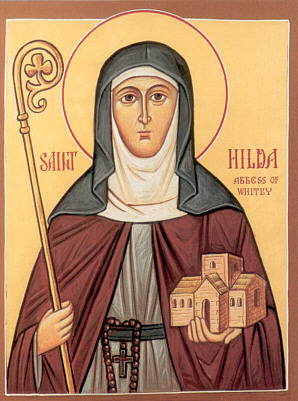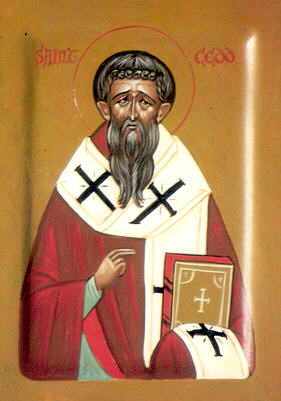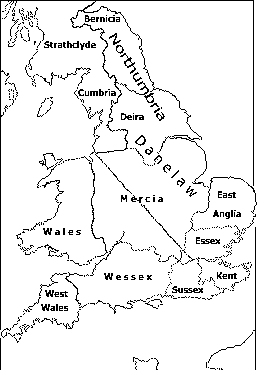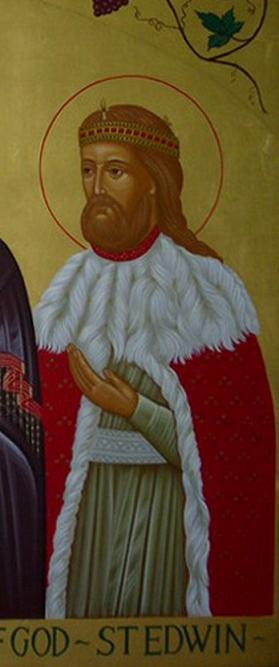The golden age of Northumbria in the seventh and eighth centuries, one of the most amazing flowerings of culture known, was based on a Northumbria filled with Irish and with Roman missionaries… It is a false dichotomy to see English and Irish in opposition in these early centuries. The true picture is of a pagan culture, that of the Anglo-Saxons, in touch with Christian culture in two ways, namely from Rome through Gaul, and from Rome through Ireland…
There were clashes between the Roman missionaries and the British, that is to say, the Welsh, Christians. Augustine wrote to ask advice from Gregory about his relationship with them and received the reply:
“We commit to you, my brother, all the bishops of Britain, that the unlearned may be instructed, the weak strengthened by your counsel, and the perverse corrected by your authority.” (Bede, “Ecclesiastical History of the English People” book 1 ch 27)
Augustine therefore invited the Welsh bishops to a conference, and urged them “that they should preserve catholic peace with him and undertake the joint labour of evangelizing the heathen for the Lord’s sake.” (ibid, bk 2 ch 2)
After a long dispute “they were unwilling, in spite of the prayers, exhortations, and rebukes of Augustine and his companions, to give their assent… They would not preach the way of life to the English nation…”
But with the Irish it was quite different, and any conflict over jurisdiction and the authority of Augustine did not flare up in his lifetime. In 664, over a hundred years after the coming of both Augustine and the Roman mission and Aidan and the Irish, a point of disagreement about the date at which Easter should be celebrated each year was seen to divide them… but it had in no way prevented joint evangelization earlier.
It is often supposed that there was an irreconcilable difference between Irish and Roman missionaries about the date of Easter, but it was in no way an anti-Irish, pro-Saxon tussle… Nor was it a quarrel between different styles of Christianity, an institutional Roman and a free-spirited Celtic; both were concerned with the same problem and went about solving it in the same ways…
There was good reason for the different datings of Easter to come to a crisis in Northumbria in the mid-seventh century. On Easter Day 627, Edwin of Northumbria received baptism with his thanes and their followers at York from Paulinus, one of the companions of Augustine sent by Pope Gregory from Rome; it was 12 April 627, a date for Easter calculated according to the Roman method. In 633, six years later, Edwin was killed in battle at Hatfield Chase and Paulinus fled with the queen to Kent. James the deacon remained behind near Catterick, and when peace was restored a year later, James (who was later present at the Council of Whitby) “instructed many in singing after the manner of Rome and the Kentish people.” (ibid, bk 2 ch 20) After a year there was bitter warfare between the pagan invaders and the new Christian claimant to the throne, Oswald, who had been in exile and received Christian baptism from monks on Iona. He became king in Northumbria and at once introduced missionaries from Iona, who followed the Irish customs. In one year, and with Roman Christians still alive and active, the Roman calculation for the date of Easter was surely still assumed to be correct in Northumbria.
The difference came with the new missionaries, friends of the king, who knew his Christianity first from the Irish, who kept Easter on a different day from the Roman missionaries, and indeed from the rest of the Church.
The second stage of the conversion of Northumbria, therefore, accidentally differed from the first in this one matter. Paulinus, Edwin, Ethelburgh, and their daughter Eanflaed, the wife of Oswiu, naturally calculated according to the modern Roman revised dating; Aidan and Oswald and Oswiu equally naturally according to the unrevised dating which had also originally come from Rome. An unconscious difference, but confusing for the Northumbrians…
For the first Anglo-Saxon Christians, Easter was the central point of the year, the moment when by baptism they entered the new life in Christ about which they had heard from the missionaries sent from Rome and from Ireland. it was not to them an arbitrary date but the pivot of the whole of the cosmos, the central moment when reality was revealed in the face of Jesus Christ… That the missionaries who preached the Gospel to them should differ about the date on which this Paschal mystery should be celebrated was both confusing and scandalous; where external practice was not something separate from internal faith, the implications of such division were not trivial…
“Easter-month, which is now called the paschal month, was formerly so called from a goddess of theirs [the English] called Eostre and since her festival was celebrated then it had that name. By that name they now call the time of pascha, customary observance giving its name to a new solemnity.” (Bede, “De Temporum Ratione, ch 15)
…
“Queen Eanflaed and her people… observed [Easter] as she had seen it done in Kent… Hence it is said that in these days it sometimes happened that Easter was celebrated twice in the same year, so that the king had finished the fast and was keeping Easter Sunday, while the queen and her people were still in Lent and observing Palm Sunday.” (Bede, Ecclesiastical History, bk 3 ch 15)
…
Easter, the moment of attention to the passion and resurrection of Christ, was not just a fest on its own that could be celebrated at a whim. on it hung the whole of the Christian year, with Lent and Pentecost around it. It was also, for Edwin of Northumbria, one of the rare moments for the entry of new members into the Church by baptism in which they, personally, after instruction, put on the living and dying of the Lord Jesus…
In his first book on the calculation of time, [Bede] linked the calculation of the date of Easter with the created world in detail: the pasch, he says, is celebrated “when the equinox is passed, that the shadow of death may be vanquished by the true light… at the turn of the moon, to show how the glory of the mind is turned from earthly things to heavenly ones… on the Lord’s Day, when the light shows the triumph of Christ and our own resurrection.” (Bede, “De Temporum Ratione” ch 59)

In his letter to Nectan [king of the Picts] he adds, “We are commanded to keep the full moon after the vernal equinox, the object being that the sun should first make the day longer than the night and then the moon can show to the world her full orb of light because the ‘Sun of righteousness with healing in his wings’ (Mal 4:2), that is, the Lord Jesus, overcame all the darkness of death by the triumph of his resurrection.” (Bede, Ecclesiastical History, bk 5 ch 21)
There was nothing there that any Irishman would object to. Why some of the Irish and also some of the English differed from the new Roman missionaries was not a matter of alternative symbolism or theology or biblical study, but of calendric calculation. It was not, as Wilfrid suggested at Whitby, because they were Quartodecimians… The Irish calculated Easter in a perfectly orthodox manner; the problem was that they were using lunar tables which had reached them from Rome and were made by Victorius of Acquitaine on a 95-year cycle, and were less accurate than those which had replaced them, that is, those of Dionysius the Small… Other differences caused the date sometimes to coincide, sometimes to be a week apart, sometimes four weeks apart. To Anglo-Saxon Christians such differences were intolerable and after 664 they, and most of the Irish, agreed to observe the new Roman Easter; by 731, even the conservative Iona had followed suit.
That was the point of discussion at Whitby. When we look at who said what and why, it was all more mixed-up than at first appears. It was not a matter of the arrogant men from Rome baring their teeth at the simple Irish at all. At the Council of Whitby, who supported each side? There was no clear-cut division in terms of nationalism.

An epitome of the mingling of traditions was seen in Hilda, the hostess of the occasion. (ibid, bk 4 ch 23) Hilda was an Anglo-Saxon princess (614-680), younger daughter of Heretic, nephew of Edwin of Northumbria… Hilda was brought up at the court of the Saxon Edwin. One sister, Hereswith… married the Saxon king of East Anglia, and then became a nun at the convent of Chelles in Gaul. Hilda was baptized with Edwin and his court on 12 April 627, aged thirteen, in the new church dedicated to St. Peter in York by Paulinus… She was thus by birth one of the Saxon invaders, and her first experience of Christianity was of that brought by the Roman missionaries. In 647, twenty years later when she was 33, Hilda decided to be a nun and went to her nephew in East Anglia for a year, planning to go join her sister in the Gaulish convent at Chelles. But she came to know and revere the missionary from Iona, Aidan, and he persuaded her to stay in England, first as part of a new group at Hartlepool. Then when the abbess Heiu left for a life of greater seclusion, Hilda became abbess. She was given charge of Aelfflaed, one-year-old daughter of King Oswiu of Northumbria, after his success at the battle of the Winwead. Two years later Oswiu gave her more land at Whitby, where she ruled a new monastery…
Hilda was hostess to the Council of Whitby where, under the influence of Aidan and Colman, she inclined at first toward the Irish side. Possibly there was a personal antagonism between her and Wilfrid, since she later accused Wilfrid to Rome in the last year of her life. Hilda died in 680, the year in which Bede entered Wearmouth. In her life there is a mixture of Anglo-Saxon, Roman and Irish elements which blended together imperceptibly.

No clear line can be drawn about others, either: Cedd of the East Saxons had been consecrated by the Irish but acted as a careful and impartial interpreter at Whitby; King Oswiu, who called the council, had been baptized by the Irish and spoke Irish but accepted in the end without hesitation the new Roman calculation. Wilfrid himself, the architect of the Roman arguments and the first Englishman to appeal to Rome, had been educated in the Irish monastery of Lindisfarne. Agilbert, who ordained Wilfrid priest, though born in Gaul had been educated in Ireland. Prince Aldfrith, who was a friend of Wilfrid, gave him the abbey of Ripon, but only after offering it to Cuthbert and Eata of Melrose, ‘who followed the Irish ways’… Aldfrith, son of a Saxon king, was a learned man, educated in Ireland, who exchanged land with Benedict Biscop in order to have a book of cosmology…
So almost everyone at Whitby had close and friendly contact with both Roman and Irish missionaries; it was not a clash of opposites, but an argument between friends on a matter the importance of which united them far more than the details divided… In this matter of the Easter date, what needed sorting out were errors of calculation, whoever did it. And likewise with conduct: no one was to be judges as Roman, English, or Irish: such divisions were not appropriate.

